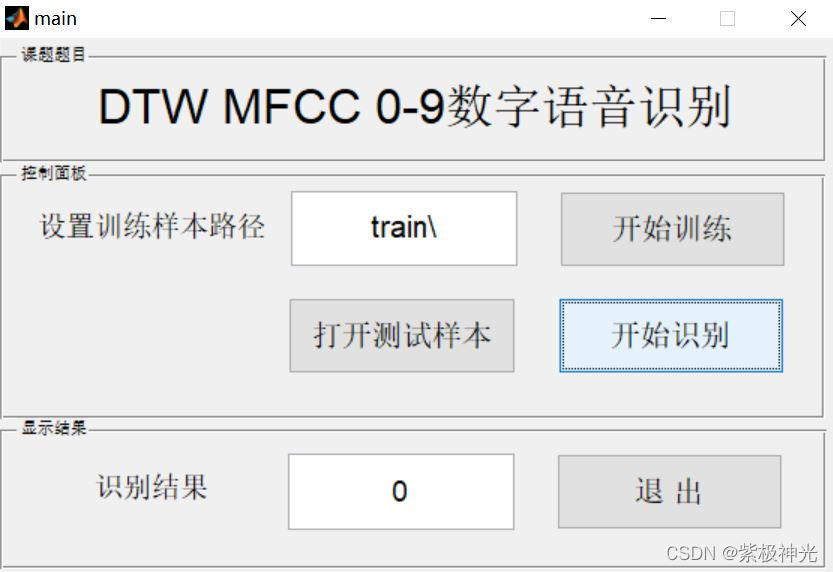【语音识别】基于matlab GUI DTW MFCC 0-9数字语音识别(带面板)【含Matlab源码 385期】
一、DTW简介(附课程作业报告)
一个应用DTW的说话人识别系统如图8-4所示。它是与文本有关的说话人确认系统。它采用的识别特征是BP FG(附听觉特征处理) , 匹配时采用DTW技术。其特点为:①在结构上基本沿用语音识别的系统。②利用使用过程中的数据修正原模板,即当在某次使用过程
中某说话人被正确确认时使用此时的输人特征对原模板作加权修改(一般用1/10加权)。
这样可使模板逐次趋于完善。

采样时间间隔为2.5ms,所存的字音模板数为15x16,即15个说话人各自的16个规定音。建立模板时,每个说话人对各字音各发音10次再经适当平均得到上述的各模板。在确认过程中,要求待确认者在他已知的116个字音中任选2~4个。先任选2个字,将2个字所得的“计分”(距离的倒数)相加,若已超过判决逻辑中所设定的阈值则予以肯定。否则,令待确认者另选16个字中其它字音并将计分加权累计,直到共发4个字音。若仍未达到阈值,则给以拒绝。
这里提供一个典型的实验结果:对于1732个真的待确认者,经此系统的错误拒绝率为
0.6%;对于630个假的待证实者,错误接受率为0.3%。当然,适当改变阈值可以调整这
两种比率。
二、部分源代码
function varargout = main(varargin)
% MAIN MATLAB code for main.fig
% MAIN, by itself, creates a new MAIN or raises the existing
% singleton*.
%
% H = MAIN returns the handle to a new MAIN or the handle to
% the existing singleton*.
%
% MAIN('CALLBACK',hObject,eventData,handles,...) calls the local
% function named CALLBACK in MAIN.M with the given input arguments.
%
% MAIN('Property','Value',...) creates a new MAIN or raises the
% existing singleton*. Starting from the left, property value pairs are
% applied to the GUI before main_OpeningFcn gets called. An
% unrecognized property name or invalid value makes property application
% stop. All inputs are passed to main_OpeningFcn via varargin.
%
% *See GUI Options on GUIDE's Tools menu. Choose "GUI allows only one
% instance to run (singleton)".
%
% See also: GUIDE, GUIDATA, GUIHANDLES
% Edit the above text to modify the response to help main
% Last Modified by GUIDE v2.5 08-Jan-2022 14:29:41
% Begin initialization code - DO NOT EDIT
gui_Singleton = 1;
gui_State = struct('gui_Name', mfilename, ...
'gui_Singleton', gui_Singleton, ...
'gui_OpeningFcn', @main_OpeningFcn, ...
'gui_OutputFcn', @main_OutputFcn, ...
'gui_LayoutFcn', [] , ...
'gui_Callback', []);
if nargin && ischar(varargin{1})
gui_State.gui_Callback = str2func(varargin{1});
end
if nargout
[varargout{1:nargout}] = gui_mainfcn(gui_State, varargin{:});
else
gui_mainfcn(gui_State, varargin{:});
end
% End initialization code - DO NOT EDIT
% --- Executes just before main is made visible.
function main_OpeningFcn(hObject, eventdata, handles, varargin)
% This function has no output args, see OutputFcn.
% hObject handle to figure
% eventdata reserved - to be defined in a future version of MATLAB
% handles structure with handles and user data (see GUIDATA)
% varargin command line arguments to main (see VARARGIN)
% Choose default command line output for main
handles.output = hObject;
% Update handles structure
guidata(hObject, handles);
% UIWAIT makes main wait for user response (see UIRESUME)
% uiwait(handles.figure1);
% --- Outputs from this function are returned to the command line.
function varargout = main_OutputFcn(hObject, eventdata, handles)
% varargout cell array for returning output args (see VARARGOUT);
% hObject handle to figure
% eventdata reserved - to be defined in a future version of MATLAB
% handles structure with handles and user data (see GUIDATA)
% Get default command line output from handles structure
varargout{1} = handles.output;
function edit1_Callback(hObject, eventdata, handles)
% hObject handle to edit1 (see GCBO)
% eventdata reserved - to be defined in a future version of MATLAB
% handles structure with handles and user data (see GUIDATA)
file_path = get( hObject , 'String' ) ;
handles.file_path = file_path ;
guidata( hObject , handles ) ;
% Hints: get(hObject,'String') returns contents of edit1 as text
% str2double(get(hObject,'String')) returns contents of edit1 as a double
% --- Executes during object creation, after setting all properties.
function edit1_CreateFcn(hObject, eventdata, handles)
% hObject handle to edit1 (see GCBO)
% eventdata reserved - to be defined in a future version of MATLAB
% handles empty - handles not created until after all CreateFcns called
% Hint: edit controls usually have a white background on Windows.
% See ISPC and COMPUTER.
if ispc && isequal(get(hObject,'BackgroundColor'), get(0,'defaultUicontrolBackgroundColor'))
set(hObject,'BackgroundColor','white');
end
% --- Executes on button press in pushbutton1.
%%选择识别样本
function pushbutton1_Callback(hObject, eventdata, handles)
% hObject handle to pushbutton1 (see GCBO)
% eventdata reserved - to be defined in a future version of MATLAB
% handles structure with handles and user data (see GUIDATA)
global file1 pathname
[file1,pathname]=uigetfile('*.wav','请选择要识别的样本');%跳出对话框
fname=fullfile(pathname,file1);
[k,fs]=wavread(fname);
sound(k,fs); %播放声音
set(handles.edit3,'string','识别结果');
% --- Executes on button press in pushbutton2.
%%开始训练按钮
function pushbutton2_Callback(hObject, eventdata, handles)
% hObject handle to pushbutton2 (see GCBO)
% eventdata reserved - to be defined in a future version of MATLAB
% handles structure with handles and user data (see GUIDATA)
warning off
file_path = get( handles.edit1 , 'String' ) ;
T=0;
h = waitbar(0,'正在训练,请稍等...');
for i=0:9
fname=fullfile(file_path,sprintf('%d0.wav',i));
[k,fs]=wavread(fname);
[StartPoint,EndPoint]=vad(k,fs);
cc=mfcc(k);
cc=cc(StartPoint-2:EndPoint-2,:);
ref(i+1).StartPoint=StartPoint;
ref(i+1).EndPoint=EndPoint;
ref(i+1).mfcc=cc;
waitbar( i/9 ) ;
end
- 1
- 2
- 3
- 4
- 5
- 6
- 7
- 8
- 9
- 10
- 11
- 12
- 13
- 14
- 15
- 16
- 17
- 18
- 19
- 20
- 21
- 22
- 23
- 24
- 25
- 26
- 27
- 28
- 29
- 30
- 31
- 32
- 33
- 34
- 35
- 36
- 37
- 38
- 39
- 40
- 41
- 42
- 43
- 44
- 45
- 46
- 47
- 48
- 49
- 50
- 51
- 52
- 53
- 54
- 55
- 56
- 57
- 58
- 59
- 60
- 61
- 62
- 63
- 64
- 65
- 66
- 67
- 68
- 69
- 70
- 71
- 72
- 73
- 74
- 75
- 76
- 77
- 78
- 79
- 80
- 81
- 82
- 83
- 84
- 85
- 86
- 87
- 88
- 89
- 90
- 91
- 92
- 93
- 94
- 95
- 96
- 97
- 98
- 99
- 100
- 101
- 102
- 103
- 104
- 105
- 106
- 107
- 108
- 109
- 110
- 111
- 112
- 113
- 114
- 115
- 116
- 117
- 118
- 119
- 120
- 121
- 122
- 123
- 124
- 125
- 126
- 127
- 128
- 129
- 130
- 131
- 132
- 133
- 134
- 135
- 136
- 137
三、运行结果










四、matlab版本及参考文献
1 matlab版本
2014a
2 参考文献
[1]韩纪庆,张磊,郑铁然.语音信号处理(第3版)[M].清华大学出版社,2019.
[2]柳若边.深度学习:语音识别技术实践[M].清华大学出版社,2019.
文章来源: qq912100926.blog.csdn.net,作者:海神之光,版权归原作者所有,如需转载,请联系作者。
原文链接:qq912100926.blog.csdn.net/article/details/114023613
- 点赞
- 收藏
- 关注作者


评论(0)